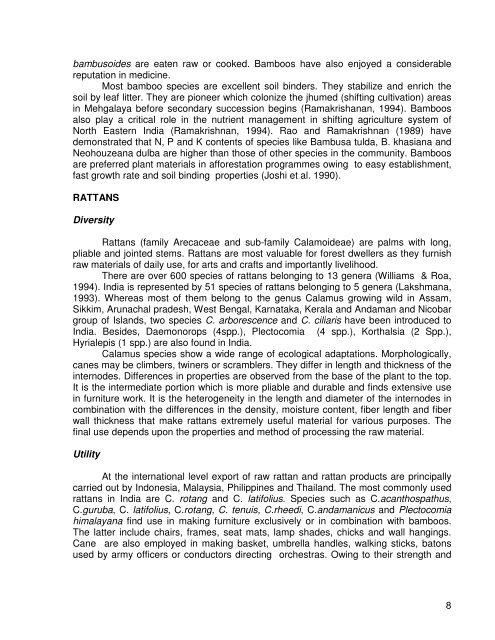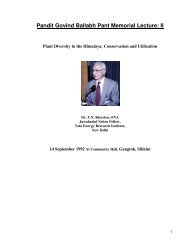Complete Lecture - Govind Ballabh Pant Institute of Himalayan ...
Complete Lecture - Govind Ballabh Pant Institute of Himalayan ...
Complete Lecture - Govind Ballabh Pant Institute of Himalayan ...
Create successful ePaper yourself
Turn your PDF publications into a flip-book with our unique Google optimized e-Paper software.
ambusoides are eaten raw or cooked. Bamboos have also enjoyed a considerablereputation in medicine.Most bamboo species are excellent soil binders. They stabilize and enrich thesoil by leaf litter. They are pioneer which colonize the jhumed (shifting cultivation) areasin Mehgalaya before secondary succession begins (Ramakrishanan, 1994). Bamboosalso play a critical role in the nutrient management in shifting agriculture system <strong>of</strong>North Eastern India (Ramakrishnan, 1994). Rao and Ramakrishnan (1989) havedemonstrated that N, P and K contents <strong>of</strong> species like Bambusa tulda, B. khasiana andNeohouzeana dulba are higher than those <strong>of</strong> other species in the community. Bamboosare preferred plant materials in afforestation programmes owing to easy establishment,fast growth rate and soil binding properties (Joshi et al. 1990).RATTANSDiversityRattans (family Arecaceae and sub-family Calamoideae) are palms with long,pliable and jointed stems. Rattans are most valuable for forest dwellers as they furnishraw materials <strong>of</strong> daily use, for arts and crafts and importantly livelihood.There are over 600 species <strong>of</strong> rattans belonging to 13 genera (Williams & Roa,1994). India is represented by 51 species <strong>of</strong> rattans belonging to 5 genera (Lakshmana,1993). Whereas most <strong>of</strong> them belong to the genus Calamus growing wild in Assam,Sikkim, Arunachal pradesh, West Bengal, Karnataka, Kerala and Andaman and Nicobargroup <strong>of</strong> Islands, two species C. arborescence and C. ciliaris have been introduced toIndia. Besides, Daemonorops (4spp.), Plectocomia (4 spp.), Korthalsia (2 Spp.),Hyrialepis (1 spp.) are also found in India.Calamus species show a wide range <strong>of</strong> ecological adaptations. Morphologically,canes may be climbers, twiners or scramblers. They differ in length and thickness <strong>of</strong> theinternodes. Differences in properties are observed from the base <strong>of</strong> the plant to the top.It is the intermediate portion which is more pliable and durable and finds extensive usein furniture work. It is the heterogeneity in the length and diameter <strong>of</strong> the internodes incombination with the differences in the density, moisture content, fiber length and fiberwall thickness that make rattans extremely useful material for various purposes. Thefinal use depends upon the properties and method <strong>of</strong> processing the raw material.UtilityAt the international level export <strong>of</strong> raw rattan and rattan products are principallycarried out by Indonesia, Malaysia, Philippines and Thailand. The most commonly usedrattans in India are C. rotang and C. latifolius. Species such as C.acanthospathus,C.guruba, C. latifolius, C.rotang, C. tenuis, C.rheedi, C.andamanicus and Plectocomiahimalayana find use in making furniture exclusively or in combination with bamboos.The latter include chairs, frames, seat mats, lamp shades, chicks and wall hangings.Cane are also employed in making basket, umbrella handles, walking sticks, batonsused by army <strong>of</strong>ficers or conductors directing orchestras. Owing to their strength and8











